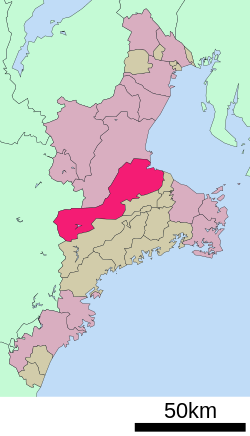|
Matsusaka
 Matsusaka (松阪市, Matsusaka-shi, Local dialect: Mattsaka or Massaka) is a city located in Mie Prefecture, Japan. As of 1 August 2021[update], the city had an estimated population of 157,235 in 66,018 households and a population density of 250 people per km².[1] The total area of the city is 623.64 square kilometres (240.79 sq mi). The city is famous for Matsusaka beef. GeographyMatsusaka is located in east-central Kii Peninsula, in central Mie Prefecture. It stretches the width of Mie Prefecture, and is bordered by Ise Bay on the Pacific Ocean to the east, and Nara Prefecture to the west. Parts of the city are within the limits of the Yoshino-Kumano National Park. Neighboring municipalitiesMie Prefecture Nara Prefecture ClimateMatsusaka has a Humid subtropical climate (Köppen Cfa) characterized by warm summers and cool winters with light to no snowfall. The average annual temperature in Matsusaka is 14.8 °C (58.6 °F). The average annual rainfall is 2,157.8 mm (84.95 in) with September as the wettest month. The temperatures are highest on average in August, at around 26.1 °C (79.0 °F), and lowest in January, at around 4.2 °C (39.6 °F).[2]
DemographicsPer Japanese census data,[4] the population of Matsusaka has been increasing slowly over the past 50 years.
HistoryMatsusaka developed as a commercial center during the Sengoku period, and Oda Nobukatsu, the younger son of Oda Nobunaga built a castle in the area in 1580. The area came under the control of Gamō Ujisato shortly thereafter, and the Gamō began construction of a castle in the Yoiho forest (四五百森, Yoiho no mori) and named the site "Matsusaka," meaning "slope (坂) covered with pines (松)" in 1588. Matsusaka Castle was the center of the short-lived Matsusaka Domain in the early Tokugawa shogunate, but for most of the Edo period, the castle was the eastern outpost of Kishu Domain based at Wakayama Castle. Following the Meiji restoration, the area became part of Mie Prefecture. The town of Matsusaka was created on April 1, 1889 with the establishment of the modern municipalities system. The second kanji character of Matsusaka was changed to 阪 from 坂 in those days. On March 26, 1893, 1318 houses in the town were destroyed in a fire. Matsusaka was raised to city status on February 1, 1933. The city suffered only light damage in World War II, when an air raid killed four people on February 4, 1945. About 700 houses in the city were destroyed by a fire on December 16, 1951. On October 15, 1956, a major railway accident occurred at Rokken Station on the outskirts of the city, killing 42 people. On August 1, 1982, Typhoon Bess left nine people dead in its wake. The city officially celebrated its 500th anniversary in 1988. On January 1, 2005, the city expanded to its present borders, with the absorption the towns of Mikumo and Ureshino (both from Ichishi District), and the towns of Iinan and Iitaka (both from Iinan District). GovernmentMatsusaka has a mayor-council form of government with a directly elected mayor and a unicameral city council of 28 members. Matsusaka contributes four members to the Mie Prefectural Assembly. In terms of national politics, the city is part of Mie 1st district of the lower house of the Diet of Japan. EducationMatsusaka has 36 public elementary schools and 12 public middle schools operated by the city government and four public high schools operated by the Mie Prefectural Board of Education. There are also one private middle school and two private high schools. The prefectural also operates two special education schools for the handicapped. Mie Chukyo University, formerly located in Matsusaka, closed in 2013. TransportationRailway
Highway
SeaportsSister cities
Local attractions
Notable people
References
External links
|
||||||||||||||||||||||||||||||||||||||||||||||||||||||||||||||||||||||||||||||||||||||||||||||||||||||||||||||||||||||||||||||||||||||||||||||||||||||||||||||||||||||||||||||||||||||||||||||||||||||||||||||||||||||||||||||||||||||||||




